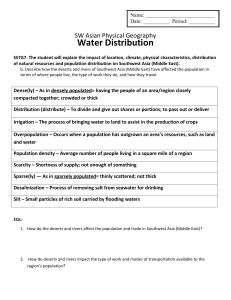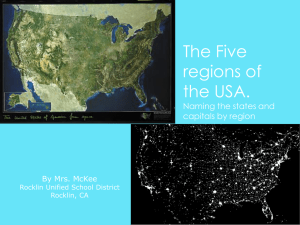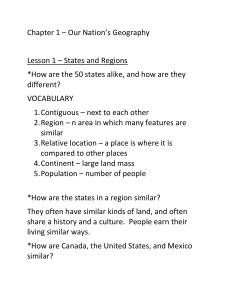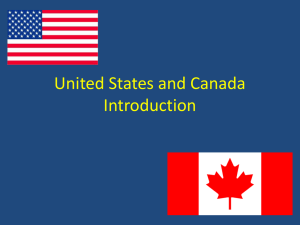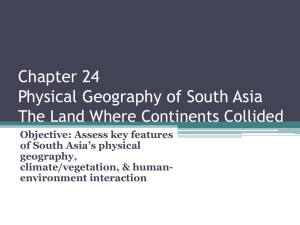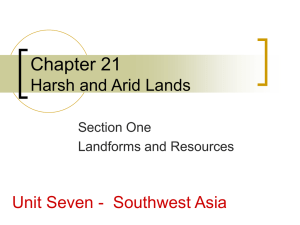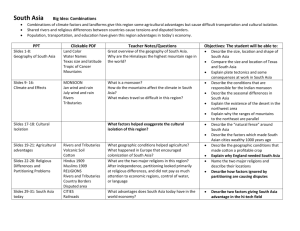ASIA
advertisement
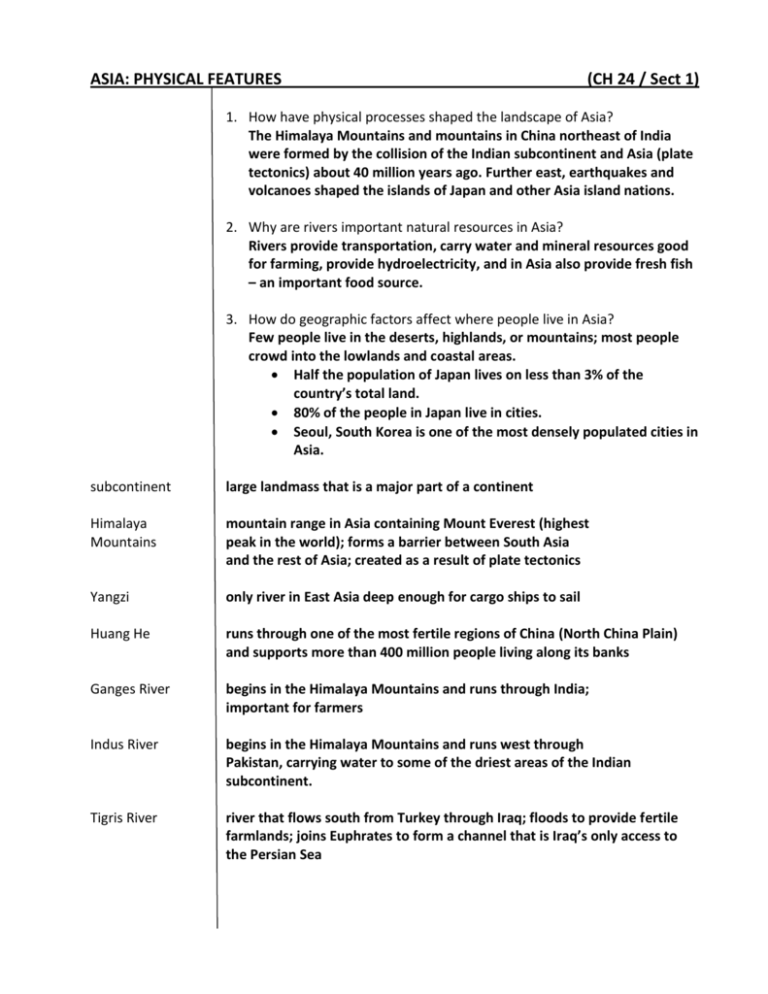
ASIA: PHYSICAL FEATURES (CH 24 / Sect 1) 1. How have physical processes shaped the landscape of Asia? The Himalaya Mountains and mountains in China northeast of India were formed by the collision of the Indian subcontinent and Asia (plate tectonics) about 40 million years ago. Further east, earthquakes and volcanoes shaped the islands of Japan and other Asia island nations. 2. Why are rivers important natural resources in Asia? Rivers provide transportation, carry water and mineral resources good for farming, provide hydroelectricity, and in Asia also provide fresh fish – an important food source. 3. How do geographic factors affect where people live in Asia? Few people live in the deserts, highlands, or mountains; most people crowd into the lowlands and coastal areas. Half the population of Japan lives on less than 3% of the country’s total land. 80% of the people in Japan live in cities. Seoul, South Korea is one of the most densely populated cities in Asia. subcontinent large landmass that is a major part of a continent Himalaya Mountains mountain range in Asia containing Mount Everest (highest peak in the world); forms a barrier between South Asia and the rest of Asia; created as a result of plate tectonics Yangzi only river in East Asia deep enough for cargo ships to sail Huang He runs through one of the most fertile regions of China (North China Plain) and supports more than 400 million people living along its banks Ganges River begins in the Himalaya Mountains and runs through India; important for farmers Indus River begins in the Himalaya Mountains and runs west through Pakistan, carrying water to some of the driest areas of the Indian subcontinent. Tigris River river that flows south from Turkey through Iraq; floods to provide fertile farmlands; joins Euphrates to form a channel that is Iraq’s only access to the Persian Sea ASIA: PHYSICAL FEATURES Euphrates River (CH 24 / Sect 1) river that flows south from Turkey through Iraq; floods to provide fertile farmlands; joins Tigris River to form a channel that is Iraq’s only access to the Persian Sea AREA Major Landforms/ Vegetation Major Bodies of Water Major Areas of Population Indian subcontinent plateau, northern plains Ganges & Indus Rivers river valleys, northern plains Southeast Asia forested mountains South China Sea river valleys, coastal areas Southwest & Central Asia deserts Tigris & Euphrates Rivers between rivers Himalaya Mountains means “snowy range.” Mount Everest grows 2” every year – proof that plate tectonics continues even today. _________________________________________________________________________________ SUMMARY: Asia’s natural resources include rivers that provide water and transportation, and fertile valleys where it is easiest for people to live and grow food. ASIA: HUMANS AND THE PHYSICAL ENVIRONMENT (CH 24 / Sect 2) 1. How does the physical environment affect people’s lives in Southwest Asia? Region of extreme climates; water is scarce; little arable land. Farmers must dig wells and irrigation channels to water crops; many select plants with long roots. (Dates are an important crops, as is alfalfa.) 2. How does the physical environment affect people’s lives in East Asia? Summer monsoons cause flooding (a blessing as it brings alluvial soil to the farmlands; a curse as flooding destroys many villages). Winter monsoons bring cooler, drier air and produce dust storms that last for days. 3. How does the physical environment affect people’s lives in South and Southeast Asia? Monsoons provide water for half the world’s populations and provide needed water for rice crops; however, mudslides in Nepal and flooding in Bangladesh destroy many villages. The tropical climate of Southeast Asia also means typhoons – just like hurricanes, only in the Pacific Ocean. arable land land that can produce crops monsoon winds that blow across a region at certain times of the year scarce does not exist in sufficient quantities to satisfy all needs for it I. Aspects and effects of the physical environment a. Southwest i. Dry climate: people must adapt farming methods ii. Limited arable land (irrigation required) b. East, South, and Southeast Asia i. Monsoons (East, South) ii. Tropical climate (Southeast Asia) _________________________________________________________________________________ SUMMARY: Throughout Asia, humans must adapt to difficult, and sometimes dangerous, physical environments. ASIA: GEOGRAPHIC FACTORS AND NATURAL RESOURCES (CH 24 / Sect 3) 1. What natural resources do people use to make a living in South and Southeast Asia? Since most people make their living from the land, land and water are important natural resources. Resources not only produce food for the family, but cash crops to be sold. 2. What natural resources do people use to make a living in South and East Asia? Pacific Ocean is an important resource for food in East Asia. Rivers and lakes are also important, as almost twice the amount of freshwater fish is caught in China than any other country. While there are many natural resources in this area, many are too difficult or too expensive to obtain. 3. How does oil wealth affect people and economic development in Southwest Asia? Southwest Asia is the largest oil-producing region in the world with half the world’s oil reserve. This provides people in countries with petroleum a high standard of living; for those in the region living in countries without petroleum, many come as migrant workers, sending paychecks to their families back in their home countries. cash crop crop raised to be sold for money on the world market aquaculture sea farming standard of living material quality of life Area South/ Southeast Asia Key Resources Problems in using resources________ Countries begin to depend on income from cash crops; when prices fall, the crops do not bring money, people go hungry. tea, rubber (cash crops) East Asia metals/minerals expensive to obtain Southwest Asia petroleum not every nation has petroleum SUMMARY: Land and water resources, along with oil, contribute to the way most people in South and Southeast Asia make their living.
